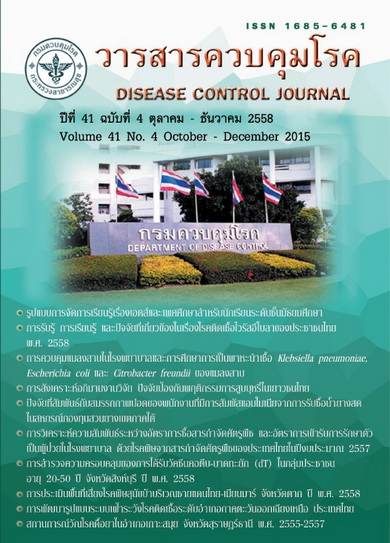Evaluation of risk areas for rabies along Thai-Myanmar border, Tak Province, 2015
DOI:
https://doi.org/10.14456/dcj.2015.8Keywords:
evaluation of risk area, rabies surveillance network, Thai-Myanmar border, One HealthAbstract
Strengthening the disease surveillance and response systems along international border was needed, and it should continuously be cooperated with all stakeholders. A network of rabies surveillance in Tak had adopted One Health approach strengthening capabilities of rabies surveillance system along Thai-Myanmar border. The goal of rabies elimination by 2020 was also motivated the capacity of rabies surveillance. The objective of this study aimed to evaluate risk areas for rabies along Thai-Myanmar border. Data were collected from rabies surveillance network both quantitative data such as survey of animal populations and vaccine coverage in animals. Reports from inspection and meeting minutes were analyzed as qualitative data. The data were described by descriptive statistics. The results found that there were human rabies deaths in Tak almost every year. Most of them were exposed to rabies from Myanmar side. There was an assumption that Myanmar had an occurrence of rabid animals and could be a potential risk of rabies for human and animals along border areas. Therefore, coverage of rabies vaccine in animal populations should be reaching to at a high level around those areas probably more than 80.0%. However, there was overall rabies vaccination coverage at 69.6% in Tak. For evaluating rabies free area in each sub-district, it found that no rabies death case and samples of animals were positive result for rabies with two consecutive years. Most of municipal governments in Tak could not conduct the rabies vaccination campaign due to the procurement process. In order to reduce the risk of rabies and accelerate rabies free area, all stakeholders should conduct campaigns to increase vaccination coverage in animals every year. In addition, municipal government should regulate the special laws to control the stray dogs.
Downloads
References
2. กรมปศุสัตว์. ระบบสารสนเทศเพื่อการเฝ้าระวังโรคพิษสุนัขบ้า [อินเทอร์เน็ต]. [สืบค้นเมื่อ 10 ส.ค. 2558]. แหล่งข้อมูล: http://www.thairabies.net/trn/ InformationDetail.aspx?ID=54
3. สำนักโรคติดต่อทั่วไป. ระบบรายงานผู้สัมผัสโรคพิษสุนัขบ้า [อินเทอร์เน็ต]. [สืบค้นเมื่อ 10 ส.ค. 2558]. แหล่งข้อมูล: http://r36.ddc.moph.go.th/r36/home
4. กรมควบคุมโรค กระทรวงสาธารณสุข, กรมปศุสัตว์ กระทรวงเกษตรและสหกรณ์. หลักเกณฑ์การสร้างพื้นที่ปลอดโรคพิษสุนัขบ้า. กรุงเทพมหานคร: โรงพิมพ์ชุมนุมสหกรณ์การเกษตรแห่งประเทศไทย จำกัด; 2552.
5. ศูนย์บริหารกฎหมายสาธารณสุข กรมอนามัย กระทรวงสาธารณสุข. คู่มือพระราชบัญญัติการสาธารณสุข พ.ศ. 2535. พิมพ์ครั้งที่ 7. กรุงเทพมหานคร: โรงพิมพ์ชุมนุมสหกรณ์การเกษตรแห่งประเทศไทย จำกัด; 2557.
6. Tenzin. Ward MP. Review of rabies epidemiology and control in South, South East and East Asia: past, present and prospects for elimination. Zoonoses Public Health 2012;59:451-67.
7. Wells CW. The control of rabies in Malaya through compulsory mass vaccination of dogs. Bull World Health Organ 1954;10:731-42.
8. Shahirudin S. Rabies in animals in Malaysia. In: Dodet B, Meslin FX, editors. Rabies control in Asia: Proceedings of the fourth international symposium, 5-9 March, 2001, Hanoi, Vietnam. Paris: John Libbey Eurotext; 2001: p. 223-7.
9. M. J. Day, U. Karkare, R. D. Schultz, R. Squires, H. Tsujimoto. Recommendations on vaccination for Asian small animal practitioners: a report of the WSAVA vaccination. Journal of Small Animal Practice 2015;56:77-95.
Downloads
Published
How to Cite
Issue
Section
License
Articles published in the Disease Control Journal are considered as academic work, research or analysis of the personal opinion of the authors, not the opinion of the Thailand Department of Disease Control or editorial team. The authors must be responsible for their articles.


.png)



